Mechanical Properties of Large-Volume Waste Concrete Lumps Cemented by Desert Mortar: Laboratory Tests
Abstract
1. Introduction
2. Materials and Experimental Program
2.1. Materials
2.2. Design Scheme
2.3. Specimen Preparation
- (1)
- Material batching: The cement, desert sand, fly ash, and water-reducing admixture were weighed according to the predetermined proportions, placed into a container, and thoroughly mixed to form a uniform dry mixture. Water was then added in three stages, mixing each time until a homogeneous paste was achieved.
- (2)
- Casting and curing: Waste concrete aggregates were manually and randomly placed into molds, simulating the natural, random filling pattern typical of backfilling open-pit mine voids, thus ensuring the realism and validity of the experiment. The prepared mortar was slowly poured into the mold from a fixed corner, allowing it to naturally infiltrate and fill gaps solely by gravity, without external vibration or compaction. Specimens were cured under standardized conditions at constant temperature and humidity (20 ± 2 °C, 95% RH) for 28 days. After curing, specimens were demolded, labeled, and organized neatly.
- (3)
- Speckle coating: One side of each specimen was sprayed with a speckle pattern, generating a random, high-contrast pattern suitable for tracking deformation and strain evolution before and after loading.
2.4. Testing Equipment
3. Results and Discussion
3.1. Failure Patterns
3.2. Stress–Strain Curve
4. Crack Development in Representative Specimens
4.1. Stress–Strain Response and Acoustic Emission Activity
4.2. Crack Damage Evolution Captured by DIC
5. Conclusions
- (1)
- Under the action of uniaxial compression load, the pure mortar failed in a single, brittle split, while mixes with the discarded concrete aggregate developed curved and branching cracks that left some residual strength.
- (2)
- For the water-to-binder ratio, mixtures in Groups 3 and 6 (ratio = 0.30) outperformed the others with average strengths of roughly 25 MPa. A lower ratio reduced the porosity and strengthened the bond between the cementitious matrix and the aggregate.
- (3)
- Particles 40–50 mm in diameter offered the best mechanical performance (average strength ≈ 22.6 MPa). This size range formed a dense load-bearing skeleton, promoted crack deflection, and dissipated energy through interface friction.
- (4)
- The AE signals revealed three damage phases. Early loading produced low-energy hits tied to pore compaction. Mid-loading showed rising amplitude and frequency as microcracks propagated and interfaces deboned. Near peak load AE activity spiked, marking crack coalescence and final collapse.
- (5)
- DIC confirmed these trends. Pure mortar exhibited a single vertical strain band, whereas aggregate mixes displayed a complex network of strains that wrapped around particles and spread along interfaces, underscoring the aggregates’ role in redirecting cracks and absorbing energy.
Author Contributions
Funding
Data Availability Statement
Acknowledgments
Conflicts of Interest
References
- Ye, L.Q.; Xu, X.C.; Gu, X.W.; Wang, Q. Ecological Cost of Open-Pit Coal Mine in Semi-arid Ecologically Fragile Area of Xinjiang. J. Northeast. Univ. (Nat. Sci. Ed.) 2023, 44, 1318–1327. [Google Scholar]
- Liu, G. Analysis of geological disaster types and control measures in coal mine goaf areas. West. Min. Eng. 2024, 36, 3–6. [Google Scholar]
- Wang, S.; Yue, Z.; Kang, Y.; Luo, L. Research on the application status and material properties of aeolian sand backfill mining. J. Min. Sci. 2024, 9, 217–232. [Google Scholar]
- Mohapatro, R.N.; Swain, R.; Routray, S.; Shadangi, K.P.; Mohanta, S.; Sarangi, P.K.; Gollakota, A.R. Recovery of filler material from mining waste: Techno-economic and kinetic study. Process Saf. Environ. Prot. 2024, 185, 918–929. [Google Scholar] [CrossRef]
- da Silva, A.; Miguel, G.D.; Daronco, J.V.L.; Coelho, P.O.D.P.; Festugato, L. Influence of curing under stress on the geomechanical response of cemented iron ore mining tailings subjected to distinct effective stress paths. Int. J. Geomech. 2024, 24, 04024159. [Google Scholar] [CrossRef]
- Zhu, T.; Chen, Z.; Cao, J.; Nian, G.; Zhang, L.; Hao, J.; Zhou, Z. Investigation of the fracture behavior of cemented waste rock-tailing backfill by digital image correlation technique and discrete element modeling. Constr. Build. Mater. 2024, 428, 136367. [Google Scholar] [CrossRef]
- Du, J.; Pan, S.; Liu, C.; Wei, Y.; Lu, Y.; Pan, H.; Qi, K.; Zhao, M.; Liu, H.; Yao, H.; et al. Key grouting technology and engineering demonstration for green mines. J. Min. Sci. 2023, 8, 293–307. [Google Scholar]
- Qiang, H. Green governance of domestic mining industry from the perspective of the Chinese path to modernization: Risks, bottlenecks and paths. Chem. Ind. Miner. Process. 2023, 52, 69–76. [Google Scholar]
- Yao, N.; Liu, Y.; Wang, Q.; Oppong, F.; Huang, T.; Zhou, Z.; Du, P. Experimental study on delamination and strength characteristics of cemented waste rock backfill. Constr. Build. Mater. 2023, 365, 130058. [Google Scholar] [CrossRef]
- Li, J.; Li, A.; Hao, J.; Xu, J.; Zhang, L. Experimental study on the ratio between ti-bearing blast furnace slag-iron-based full tailing sand and cement in cementitious filling. J. Min. Sci. 2023, 8, 838–846. [Google Scholar]
- Liu, F. Surrounding Rock Control Technology of Large Section Chambers in Deep Goaf of Coal Mines. Shanxi Coal 2024, 44, 18–23. [Google Scholar]
- Tang, Y.; Zhang, L.; Lu, H. Study on proportion optimization of coal-based solid wastes filling materials. J. Min. Sci. Technol. 2019, 4, 327–336. [Google Scholar]
- Yu, W.; Sun, M.; Du, J.; Chen, G.; Wang, C. Research progress on the approach for ecological restoration of mines, emission reduction, and carbon sink growth under the goal of carbon peak and carbon neutrality. Min. Saf. Environ. Prot. 2025, 52, 38–46. [Google Scholar]
- Du, K.; Xie, J.; Xi, W.; Wang, L.; Zhou, J. Construction practices of green mines in China. Sustainability 2024, 16, 461. [Google Scholar] [CrossRef]
- Wang, X.; Wang, Z.; Xu, H.; Zhang, S.; Zhang, F. Rheological Properties and Consolidation Mechanism of Cement-Fly Ash Cemented Gangue Backfill Material. Nonferrous Met. Eng. 2024, 14, 134–143. [Google Scholar] [CrossRef]
- Jia, X.; Feng, G. Influence of Fine Aggregate from Waste Concrete on the Performance of Backfill Paste. Min. Res. Dev. 2015, 35, 37–40. [Google Scholar]
- Ding, X.; Du, H.; Wu, E.; Yi, P.; Li, Y.; Luo, Y.; Liu, W. Investigating the Hydration, Mechanical Properties, and Pozzolanic Activity of Cement Paste Containing Co-Combustion Fly Ash. Buildings 2024, 14, 130. [Google Scholar] [CrossRef]
- Hong, Z.J.; Li, Z.H.; Du, F.; Xu, L.; Zhu, C. Experimental investigation of the mechanical properties and large-volume laboratory test of a novel filling material in mining engineering. Geomech. Geophys. Geo-Energy Geo-Resour. 2023, 9, 46. [Google Scholar] [CrossRef]
- Zhang, M.; Liu, H.; Sun, S.; Chen, X.; Doh, S.I. Dynamic mechanical behaviors of desert sand concrete (DSC) after different temperatures. Appl. Sci. 2019, 9, 4151. [Google Scholar] [CrossRef]
- Wang, H.; Wang, Q.; Gao, T.; Wang, J.; Sun, C.; Ji, Z.; Meng, J.; Ta, B. Analysis of strength failure in gangue-based cementitious backfill body from a microscopic perspective. PLoS ONE 2024, 19, e0300102. [Google Scholar] [CrossRef]
- Wang, J.; Li, H.; Qiu, Z. Study on mechanical properties of recycled large aggregate-self-compacting mortar rock-filled concrete. J. Archit. Sci. Eng. 2023, 40, 21–27. [Google Scholar]
- Wang, H.; Ma, J.; Zhou, H.; He, S.; Jin, F. Uniaxial compressive mechanical properties of rockfill concrete. J. Tsinghua Univ. (Sci. Technol.) 2022, 62, 339–346. [Google Scholar]
- Ruslan, H.N.; Muthusamy, K.; Yahaya, F.M.; Fauzi, M.A.; Ismail, M.A.; Ali, Z. Review on performance of self-compacting concrete containing solid waste and bibliometric properties: A review. J. Build. Eng. 2024, 86, 108752. [Google Scholar] [CrossRef]
- Alterary, S.S.; Marei, N.H. Fly ash properties, characterization, and applications: A review. J. King Saud Univ. Sci. 2021, 33, 101536. [Google Scholar] [CrossRef]
- GB 175-2007; Common Portland Cement. Standards Press of China: Beijing, China, 2007.
- Wang, X.; Liu, S.; Liu, X.; Shan, T.; Zhou, X.; Xie, H.; Wang, J. Mode I fracture propagation and post-peak behavior of sandstone: Insight from AE and DIC observation. Eng. Fract. Mech. 2024, 302, 110093. [Google Scholar] [CrossRef]
- GB/T 50081-2019; Standard for Test Methods of Physical and Mechanical Properties of Concrete. Standards Press of China: Beijing, China, 2019.
- Hou, C.; Wang, C.; Dias, D. Damage Constitutive Model for Freeze-Thawed Rock: Considering Damage Threshold and Residual Strength. Geotech. Geol. Eng. 2025, 43, 1–13. [Google Scholar] [CrossRef]
- Cui, Y.; Pu, Y.; Chen, Z.; Mengli, D.; Chen, J. Experimental study on the mechanical properties and crack evolution patterns of sandstone with prefabricated double fractures in the sub-instability stage. J. Min. Sci. Technol. 2025, 10, 194–202. [Google Scholar]
- Siddique, S.; Jang, J.G. Assessment of molybdenum mine tailings as filler in cement mortar. J. Build. Eng. 2020, 31, 101322. [Google Scholar] [CrossRef]
- Chen, G.; Yao, N.; Ye, Y.; Fu, F.; Hu, N.; Zhang, Z. Study on mechanical properties and damage characteristics of cemented waste rock-tailing backfill. Environ. Sci. Pollut. Res. 2023, 30, 102181–102197. [Google Scholar] [CrossRef]

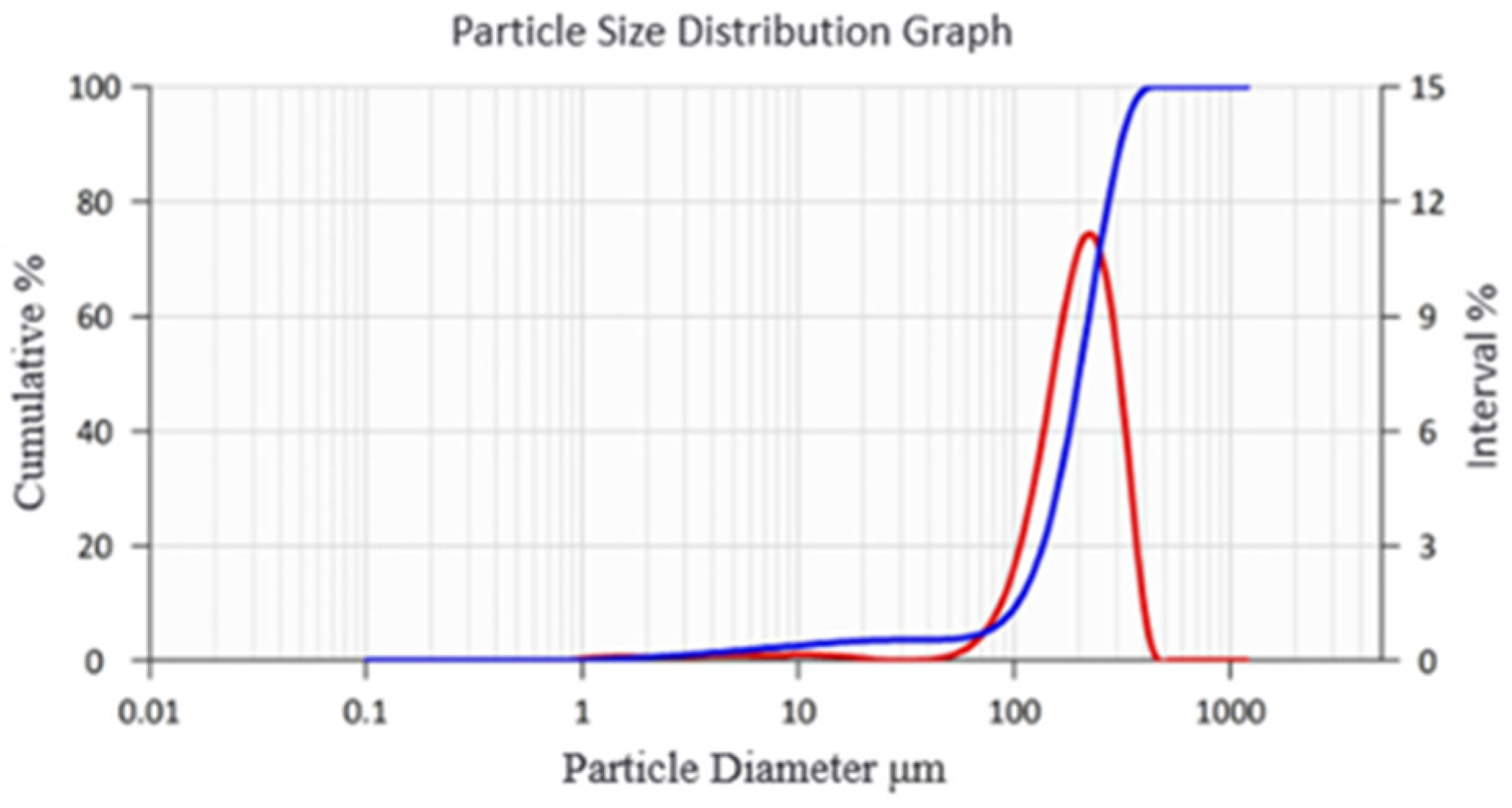


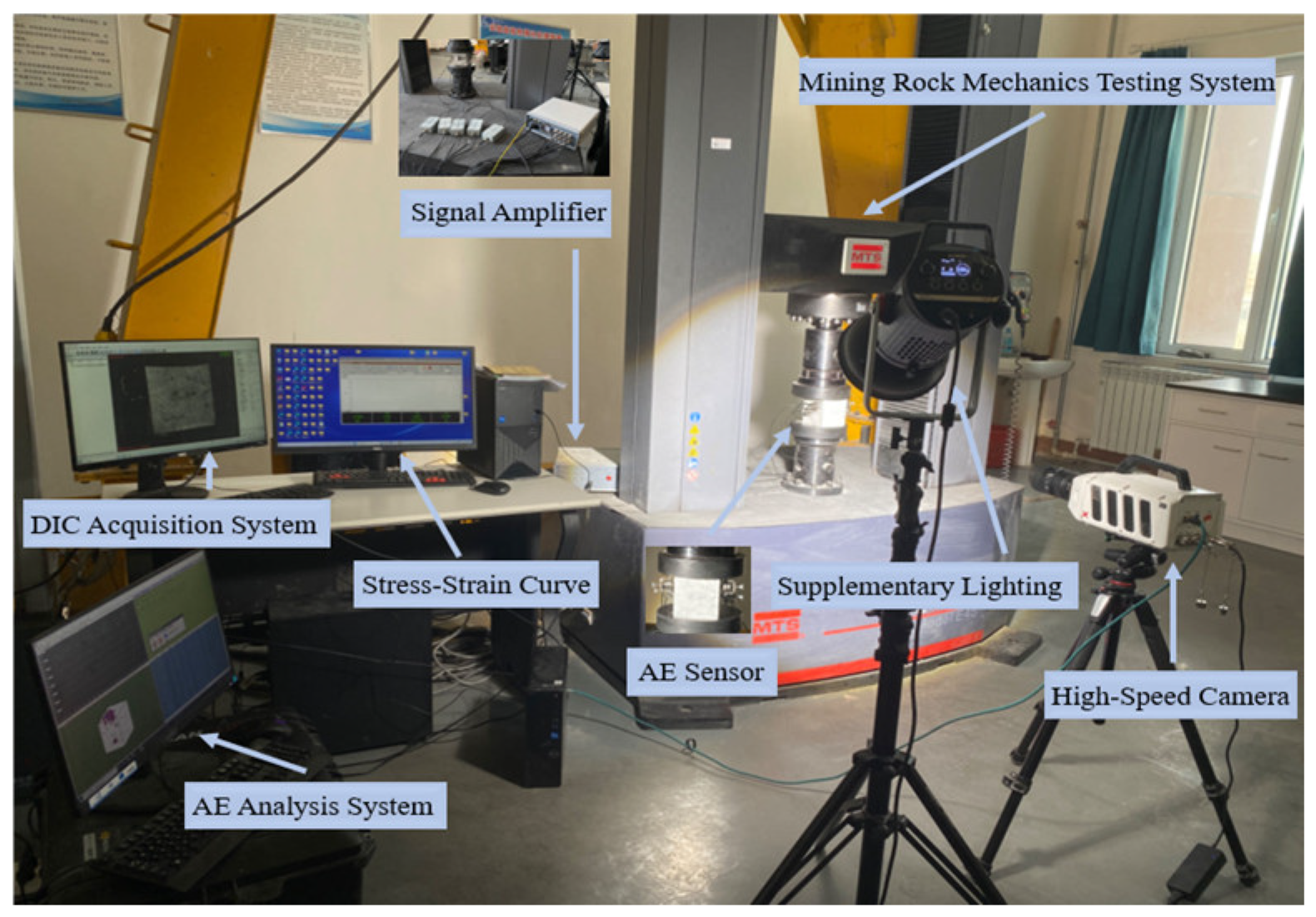

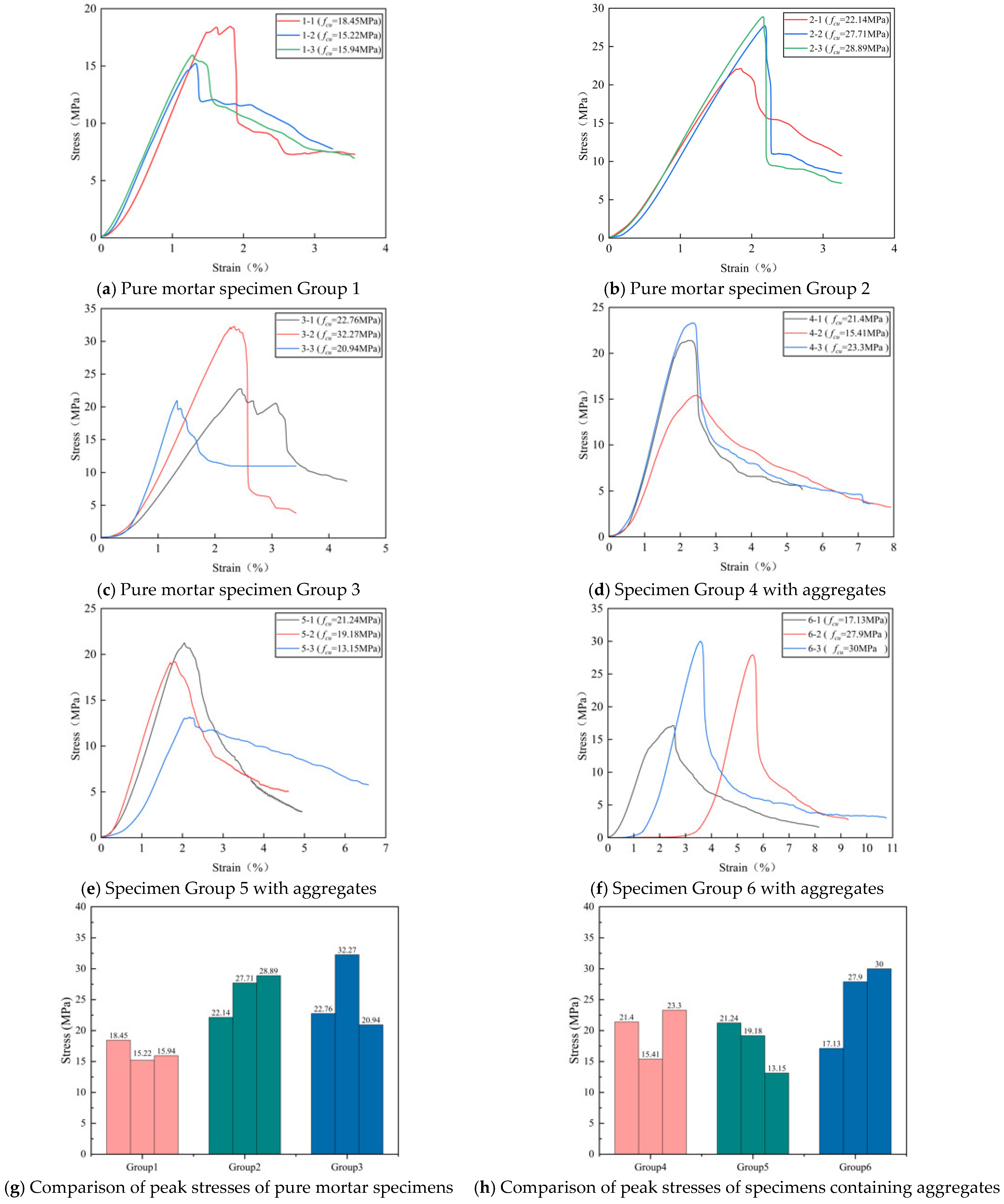

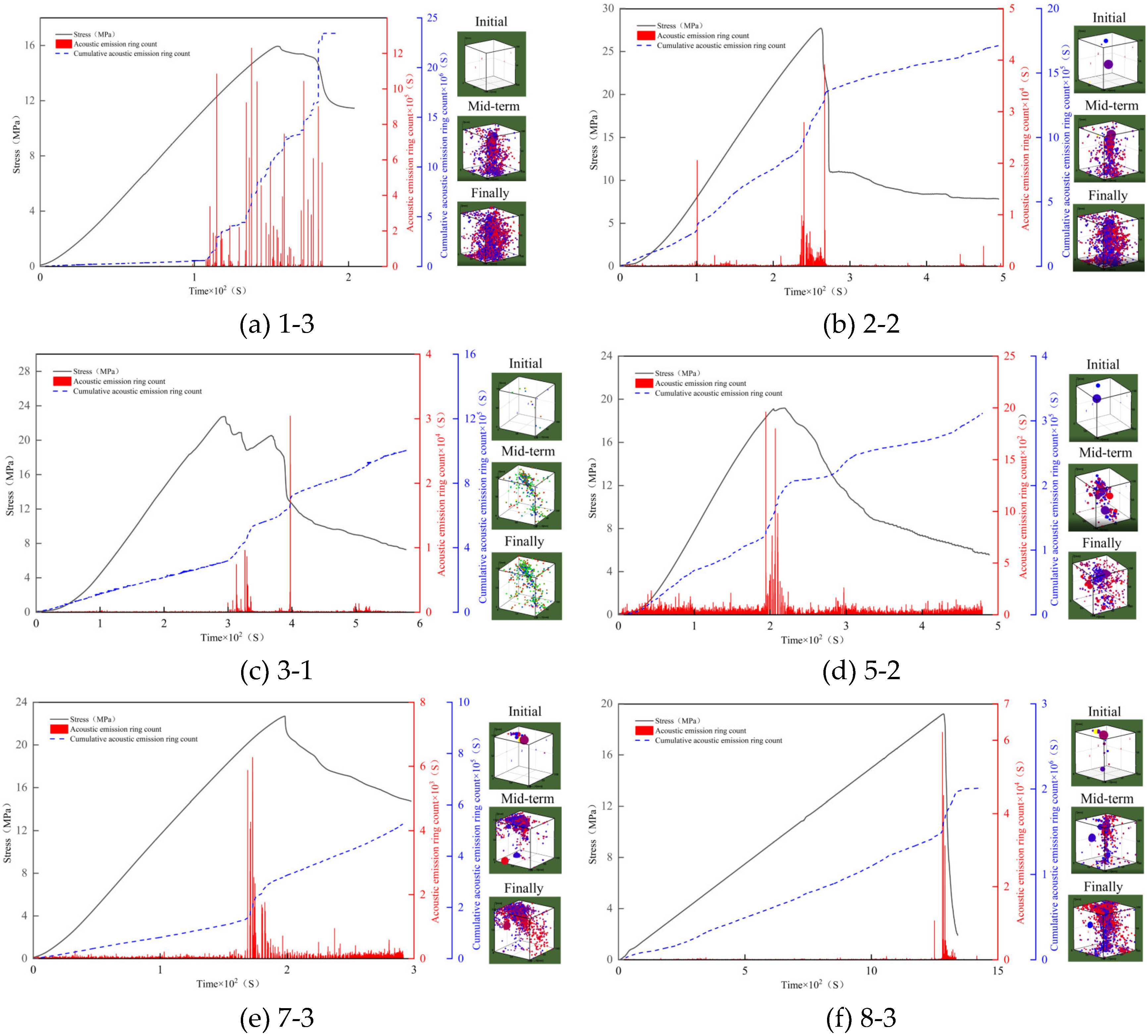
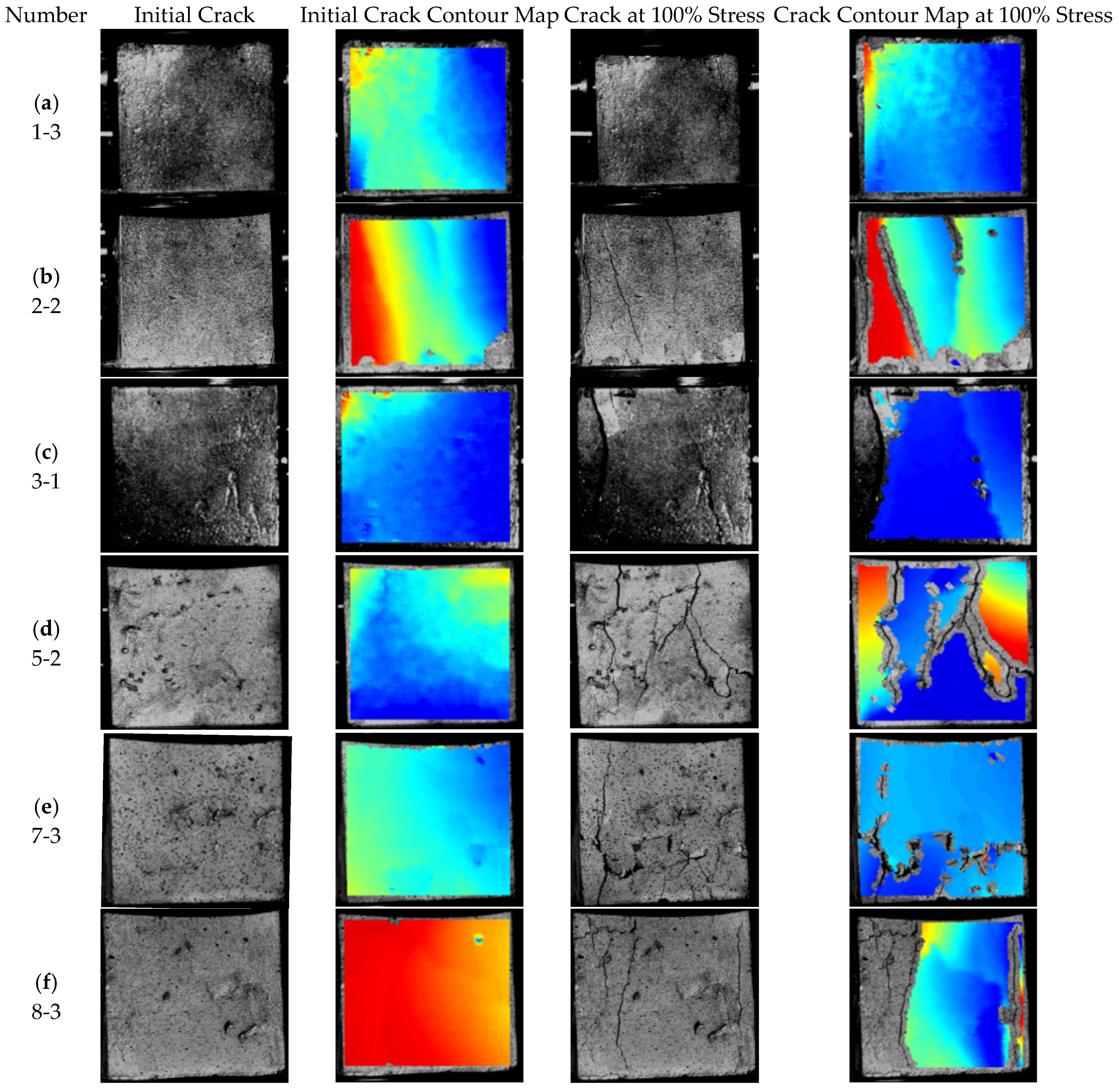
| Number | 1 | 2 | 3 | 4 | 5 | 6 | 7 | 8 | 9 |
| Rc/MPa | 44.79 | 39.45 | 50.17 | 48.07 | 43.19 | 47.6 | 53.52 | 59.77 | 47.11 |
| Number | 10 | 11 | 12 | 13 | 14 | 15 | 16 | 17 | 18 |
| Rc/MPa | 45.11 | 56.27 | 50.5 | 63.45 | 43.56 | 50.6 | 42.61 | 59.13 | 56.07 |
| Detection Limit | Al2O3 | W | La | Li | SiO2 | CaO |
|---|---|---|---|---|---|---|
| Measured Value | % | μg/g | μg/g | μg/g | % | % |
| Detection limit | 0.01 | 10 | 10 | 10 | 0.01 | 0.01 |
| Measured value | 5.28 | 10 | 20 | 20 | 24.70 | 56.6 |
| Item | Fineness (%) | Water-Demand Ratio | Loss on Ignition (%) | Moisture (%) | SO3 (%) | Free CaO (%) | Alkali Content (%) |
|---|---|---|---|---|---|---|---|
| Test results (%) | 8.0 | 80 | 2.0 | 0.1 | 1.5 | 0.2 | 0.1 |
| Number | Water | Fly Ash | Cement | Desert Sand | Aggregate Size | Superplasticizer | Aggregate Percentage | |
|---|---|---|---|---|---|---|---|---|
| (ml) | (g) | (g) | (g) | (mm) | (g) | (%) | ||
| Pure mortar subgroup | 1 | 210 | 52.5 | 472.5 | 720 | 0 | 1 | 0 |
| 2 | 210 | 60 | 540 | 720 | 0 | 1 | 0 | |
| 3 | 210 | 70 | 630 | 720 | 0 | 1 | 0 | |
| Aggregate- containing subgroup | 4 | 210 | 52.5 | 472.5 | 720 | 30~40 | 1 | 42.6 |
| 5 | 210 | 60 | 540 | 720 | 30~40 | 1 | 41.4 | |
| 6 | 210 | 70 | 630 | 720 | 30~40 | 1 | 39.9 | |
| 7 | 210 | 60 | 540 | 720 | 40~50 | 1 | 41.4 | |
| 8 | 210 | 60 | 540 | 720 | 50~60 | 1 | 41.4 |
Disclaimer/Publisher’s Note: The statements, opinions and data contained in all publications are solely those of the individual author(s) and contributor(s) and not of MDPI and/or the editor(s). MDPI and/or the editor(s) disclaim responsibility for any injury to people or property resulting from any ideas, methods, instructions or products referred to in the content. |
© 2025 by the authors. Licensee MDPI, Basel, Switzerland. This article is an open access article distributed under the terms and conditions of the Creative Commons Attribution (CC BY) license (https://creativecommons.org/licenses/by/4.0/).
Share and Cite
Chen, H.; Qi, Z.; Yu, B.; Li, X. Mechanical Properties of Large-Volume Waste Concrete Lumps Cemented by Desert Mortar: Laboratory Tests. Buildings 2025, 15, 2060. https://doi.org/10.3390/buildings15122060
Chen H, Qi Z, Yu B, Li X. Mechanical Properties of Large-Volume Waste Concrete Lumps Cemented by Desert Mortar: Laboratory Tests. Buildings. 2025; 15(12):2060. https://doi.org/10.3390/buildings15122060
Chicago/Turabian StyleChen, Hui, Zhiyuan Qi, Baiyun Yu, and Xinyu Li. 2025. "Mechanical Properties of Large-Volume Waste Concrete Lumps Cemented by Desert Mortar: Laboratory Tests" Buildings 15, no. 12: 2060. https://doi.org/10.3390/buildings15122060
APA StyleChen, H., Qi, Z., Yu, B., & Li, X. (2025). Mechanical Properties of Large-Volume Waste Concrete Lumps Cemented by Desert Mortar: Laboratory Tests. Buildings, 15(12), 2060. https://doi.org/10.3390/buildings15122060





